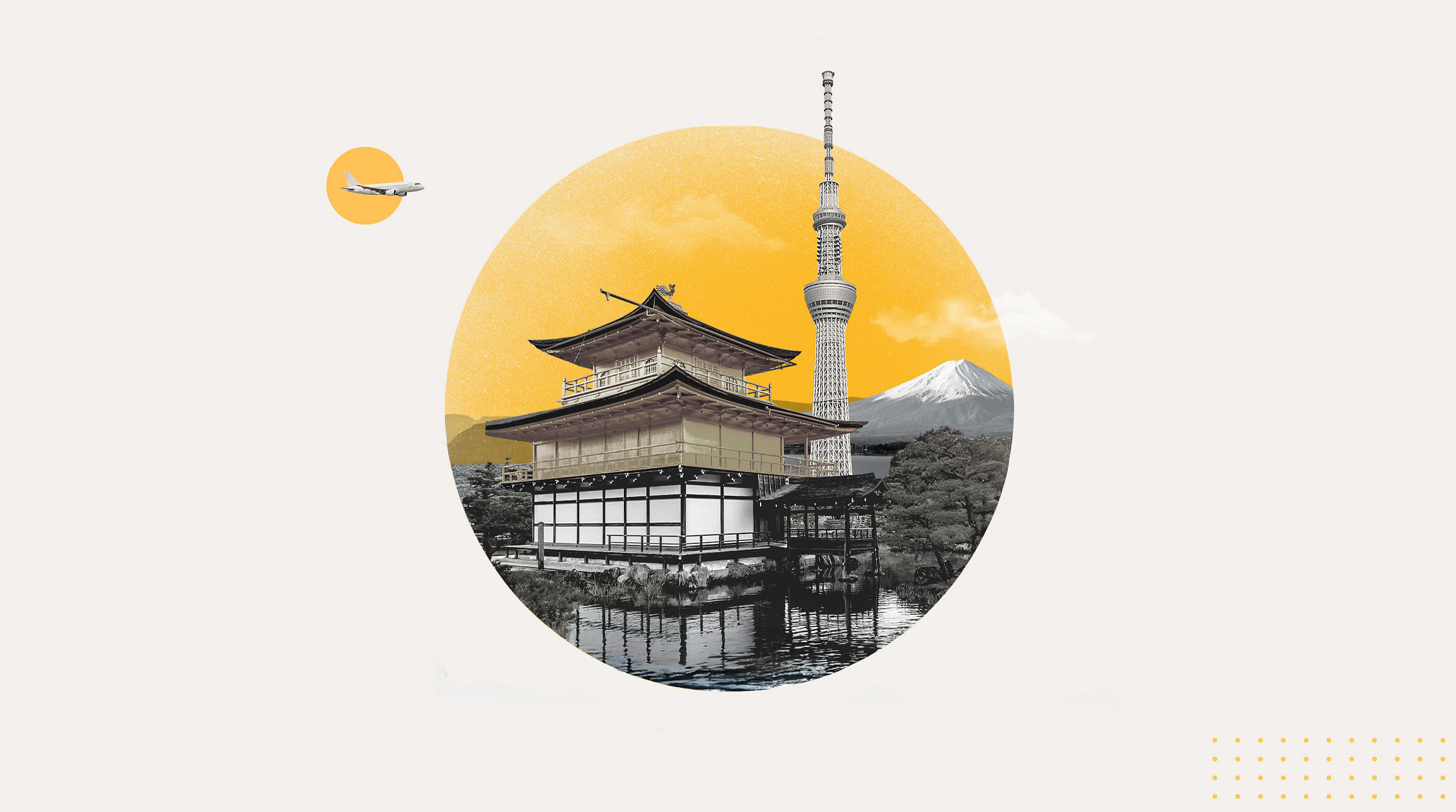
Japan is a magnet for curious British travellers.
Maybe it’s the centuries of samurai history, the sci-fi-level tech, the iconic video games, the pastel-soaked kawaii culture or the thrill of buying life's essentials from a vending machine.
Whatever the reason behind Japan's enduring pull, its popularity with Brits isn't slowing.
In fact, 437,230 British tourists visited Japan in 2024 - the highest number in a decade.
Japan's Developing Relationship With The Outside World
It's important to know before you go that Japan is as modest and reserved as it is alternative and futuristic.
And Japanese society ultimately runs on a strong respect for tradition, social harmony and a dedicated work ethic.
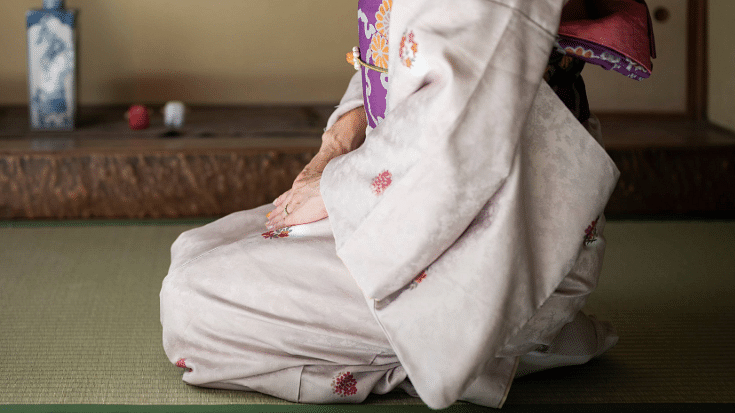
Adobe Free Stock / Monet
It's also a place that is still coming to terms with its popularity.
Historically, Japan remained largely closed to the outside world for over two centuries, only beginning to reopen in the mid-1800s.
This legacy still shapes its cautious approach to global tourism today.
And now, in 2025, a significant surge in visitors following two years of pandemic-induced closure has left Japanese authorities with the task of managing the crowds it attracts.
With almost 37 million tourists hitting its shores in 2024, Japan also faces the increasingly thorny challenges that come with overtourism.

Image by songping wang from Pixabay
How Not to Be A Bad Tourist in Japan - Etiquette Tips From a Former British Expat
One of these challenges is Japan's traditional and routine-reliant society adapting to the ways and manners of visitors from all over the world.
If you're visiting Japan for the first time, here are ten ways you can help it on that journey.
These tips are things I learned over my year of living in the country as a teacher.
I watched and absorbed a great deal from working with teachers, parents, children and even Buddhist monks along the way.
So, grab Duolingo and practice your deepest bow while I take you through how to keep things respectful, thoughtful and polite on your big adventure out East.
1. Learn to Speak and Read Some Everyday Phrases

Japanese is a tough language to completely master.
With over 50,000 characters making up Kanji, one of its three main writing systems, most Japanese people only learn a subset of around 2,000.
But when it comes to learning a few basics, Japanese is not as difficult as it might seem.
And for a little effort, you'll see a lot of reward.
Learn to speak a few phrases and recognise some symbols from its phonetic alphabets Hiragana and Katakana.
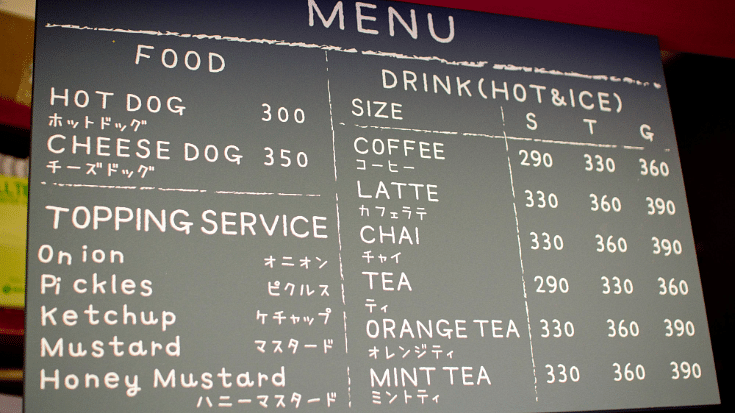
Wikimedia Commons / Sig
With this, you'll be able to greet baristas, ticket vendors, servers in small bars and izakayas and cashiers in department stores.
A little goes a long way and it will surely be appreciated.
2. Be Prepared to Re-Sit Your Toilet Training Exams
Toilets are a prime example of how Japan is simultaneously old-school and ridiculously futuristic.
It's the birthplace of electronic toilets that heat themselves on cold winter mornings.
With control panels, retractable bidets with various pressures and soundtracks to protect your modesty.
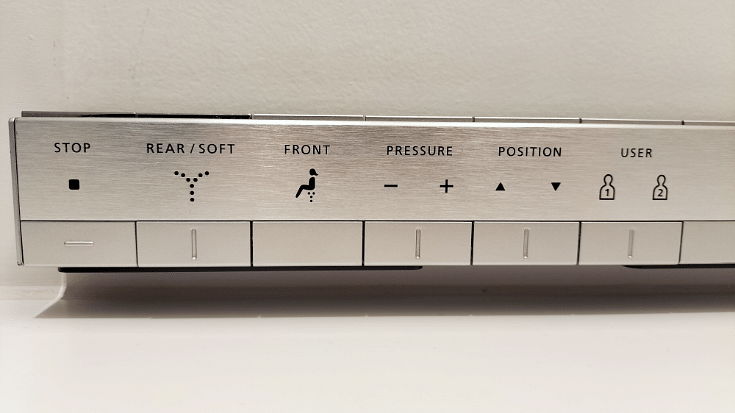
Image owned by author
On the other hand, you'll come across old-school squat toilets in traditional restaurants, roadside stops, local coffee shops and train stations.
And which type of toilet you get is often pure roulette.
So, for first-time visitors to Japan, preparing yourself for the squat experience is essential.
I appreciate that this is easier said than done.
It took me a couple of months into my life in Japan to confront my unreasonable aversion to the squat. But I’m glad I did.
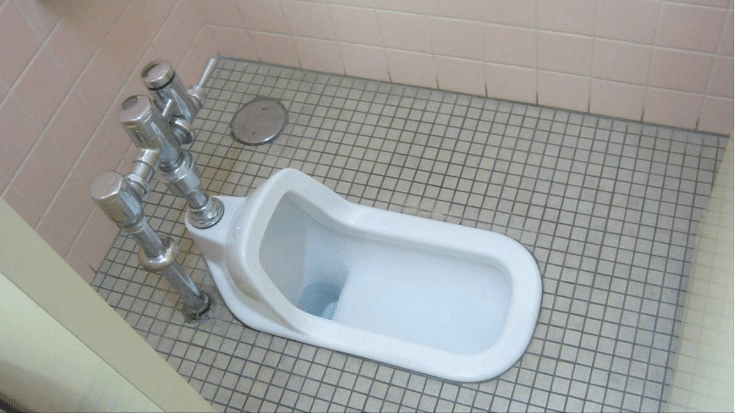
Wikimedia Commons / 浪速丹治
You'll make life way easier for yourself and save time looking for and queuing for Western toilets.
And you'll realise that squats really aren't bad - they're just different.
3. Hold the PDAs
Although it's an everyday sight in many countries, Japanese people are particularly uncomfortable with public displays of affection (PDAs).
You won't see couples kissing or cuddling on the street in Japan - it's just not the norm.
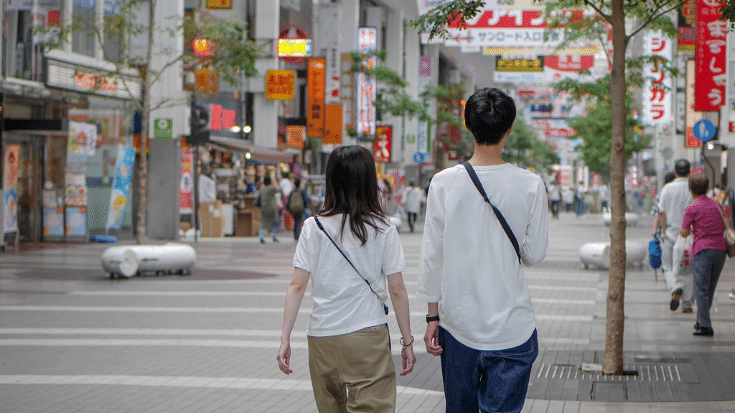
Image by Kohji Asakawa from Pixabay
This is a culture that leans towards modesty, tradition and putting the group before the individual.
Holding hands is about as intimate as you might see people get. Even bowing is a preferred greeting over a firm handshake.
Although Japanese people aren't fans of confrontation, especially in public, you'll receive disapproving stares and maybe even a tut or two.
So, if in doubt, leave it out.
4. Drinking in Company? Don't Top Up Your Own Glass
In Japanese drinking culture, you're not supposed to pour your own drink.

Adobe Free Stock / rrice
Being considerate without being asked is a much-loved trait and part of Japan's broader etiquette theme of omoiyari, i.e., showing empathy and thoughtfulness towards others.
It also ties into the unspoken rule of mutual care and attention.
So, to earn some etiquette points with your Japanese drinking buddies, keep an eye on their glasses and offer to pour when they're running low.
Not only will they return the favour, but you'll also be honouring the quiet ritual of creating a continuous, subtle rhythm of social bonding.
If your glass is empty and no one's clocked it, gently topping up someone else's is usually enough to get your companion pouring again.
5. Don't Eat On The Go
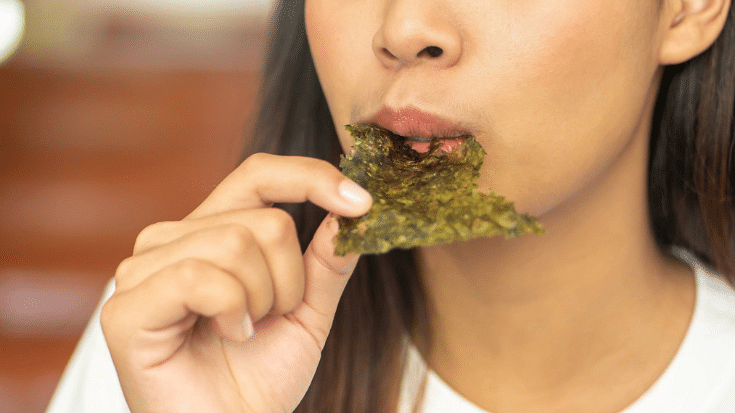
Adobe Free Stock / 9nong
This one is an etiquette minefield, so hold on tight.
In Japan, there are a fair few unwritten rules about eating in public and on the go.
Eating on the move is frowned upon, even if it's something small. Again, it all goes back to the no-no of imposing on others.
Crumbs, smells, chewing sounds. They're likely to be taken as inconsiderate in crowded spaces.
Instead, locals will usually wait until they've arrived or step aside somewhere more private.
To make this all even more difficult to navigate, there's a thin line between OK and taboo. Here's a breakdown.
Public Transport
It's best to avoid eating on local trains, subways, buses and trams.
Long-Distance Trains
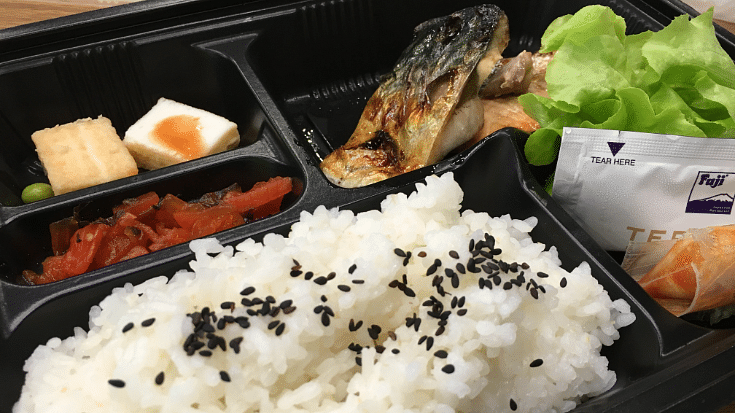
Image by ppkpichch from Pixabay
It's fine to eat on long-distance trains where you'll be sitting down for a while.
For example, on shinkansens, eating is outright encouraged.
The seats often have small inbuilt arm trays especially for settling down and tucking in.
You'll often see people eating beautiful ekiben, or station lunch boxes, while zooming through the countryside.
It's clean, quiet, respectful - the gold standard of public dining.
Eating While Walking
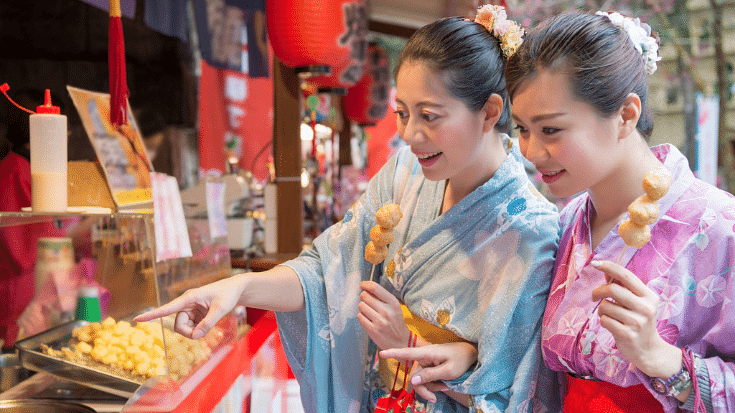
Adobe Free Stock / PR Image Factory
In most of Japan, this is considered poor manners.
It can make you look rushed, careless or selfish, especially if you drip or spill anything.
People generally stand aside quietly to finish their snacks, even at street food stalls.
During big festivals or in certain parts of Osaka where street food is part of the culture, the unwritten rules may not be so rigid.
Check what's going on around you if in doubt.
Vending Machine Etiquette
You may wonder why these social rules exist in a country jammed with vending machines.
The answer is that, you guessed it, vending machines also have an etiquette of their own.
If you fancy a can of hot coffee on a cold train platform, go for it.

Adobe Free Stock / One
Just try to stay close to the vending machine as you drink/eat and use the litter bin by the machine. And avoid taking open drinks onto crowded trains.
When all's said and done, eating in public isn't the worst thing you can do in Japan.
I’ve done it myself when hunger struck after long days teaching, followed by hours of commuting.
Take it from me though - people won't love it.
And drawing attention to yourself when you already stick out like a sore thumb isn't a comfortable feeling.
6. Gestures To Avoid in Japan
Something I was immediately briefed on when starting my life as a teacher in Japan is that there's a long list of gestures and actions that are big ole’ cultural no-nos.
Although you may be forgiven for them as a tourist, you'd do well to avoid any of the following.
Pointing at People

Adobe Free Stock / Prostock-studio
Pointing directly at someone with your finger is considered rude, aggressive and confrontational. It’s a bit like wagging your finger in their face.
If you need to indicate a person, it's more polite to gesture with an open hand, palm up.
Use your whole hand or nod subtly in their direction.
Touching Someone's Head
Heads are considered to be the most sacred and personal part of the body in Japan. Especially in older or more traditional circles.
This is tied to a mix of Buddhism, Confucian values and deep cultural traditions around personal space and respect.
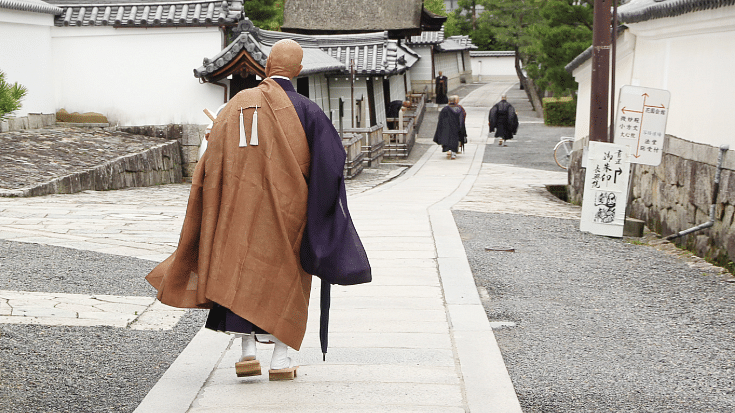
Adobe Free Stock / rudiuk
Even playfully or affectionately, touching someone's head can come off as invasive or disrespectful.
This applies even more so with elders, colleagues and strangers - it's just not done.
So if the urge comes over to scampishly ruffle someone's hair, take a hard pass, even if they’re adorable.
Waving With Your Palm Up To Call Someone Over
Looks normal to Westerners. To the Japanese? Very rude.
It's used to summon animals or sometimes subordinates. Do this instead: Put your palm down, with your fingers flapping towards you.
The 'V Sign' Behind Someone's Head For A Photo
In the UK, it's cheeky and occasionally funny. In Japan, it might come off as disrespectful, especially with strangers or elders.
Crossing Your Arms Into An ‘X’

Adobe Free Stock / Click Studio
This gesture is very strong and means "no" or "absolutely not".
It's sometimes used by staff or officials to block access or refuse entry.
Avoid doing this jokingly - it might create a scene or be taken seriously.
Tapping your Forehead or Temple to Signal ‘Oops’ or ‘I Forgot’
In some Western cultures, it's harmless. In Japan, it can seem insulting or silly depending on who you're with.
Sticking Your Chopsticks Upright In Rice
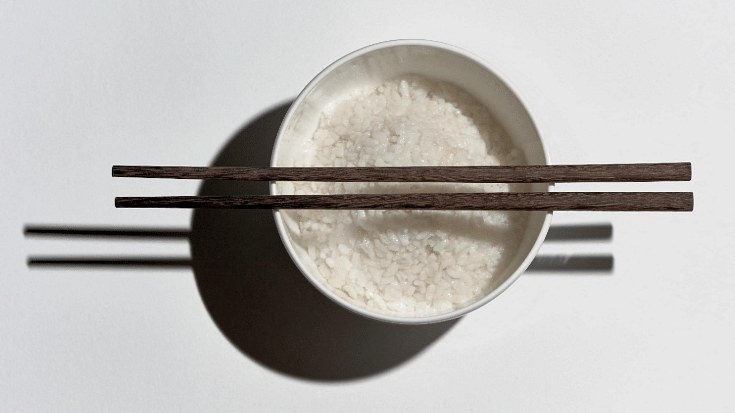
Not a gesture per se, but worth mentioning. Chopsticks standing up in rice mirrors a funeral rite. So it's best to avoid this.
Instead, if there are no hashioki, or chopstick rests, it's perfectly fine to balance your chopsticks across the rim of your bowl.
7. Avoid Feet Faux Pas in Japan

Adobe Free Stock / Cultura Allies
Feet are considered the least clean part of the body in Japanese culture.
So using them to indicate something is like pointing with a bin lid. Bear in mind to avoid the following.
- Touching or nudging things with your feet - Kicking your backpack aside, nudging a chair or moving something out of the way casually isn't great. If it’s someone else's belongings? Even worse. Use your hands or politely ask for help instead.
- Resting your feet on chairs, benches or tables - This is considered very bad manners, especially in public or shared spaces.
- Sitting with your soles facing others - If you cross your legs and your soles are pointing at someone, it can be taken as deeply rude. Especially in formal company or in the presence of elders.
If you're unsure about gesturing in Japan, go small, polite and subtle.
Japanese culture loves quiet awareness over bold signals.
8. Avoid Tokyo's Rush Hour Trains with Big Bags
If you're travelling on Tokyo's trains during rush hour with a suitcase or backpack the size of a fridge, you're going to regret it.
And so will everyone around you.
Between 07:30 and 09:00 and again around 17:00 to 19:00, trains are absolutely rammed.
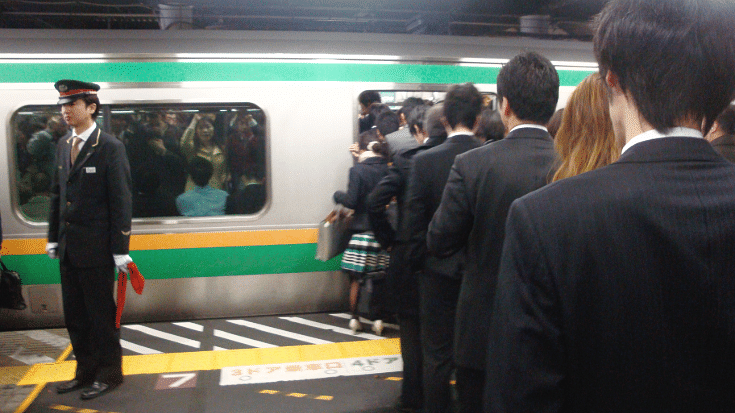
Wikimedia Commons / David Pursehouse
Think sardines in a tin, but somehow with less personal space.
Seriously - there's barely room to breathe, let alone for your rolling suitcase.
If you can, travel off-peak or stash your big bags in station lockers or at your hotel before heading out.
You'll save yourself stress, side-eyes and possibly tripping someone over with your luggage.
9. Get Familiar with Shoe Rules
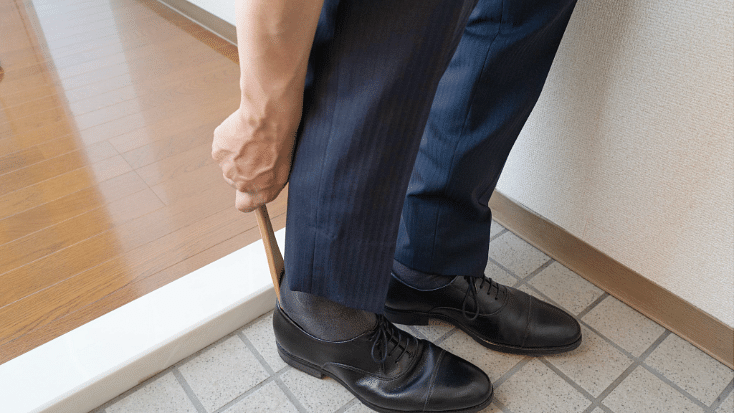
Adobe Free Stock / aomas
Wearing outdoor shoes indoors is just not done in Japan.
So prepare yourself for some regular slipping on and off and getting familiar with the different types of indoor shoes and protocols around shoes.
Here are some at-a-glance must-knows.
In A Japanese Home
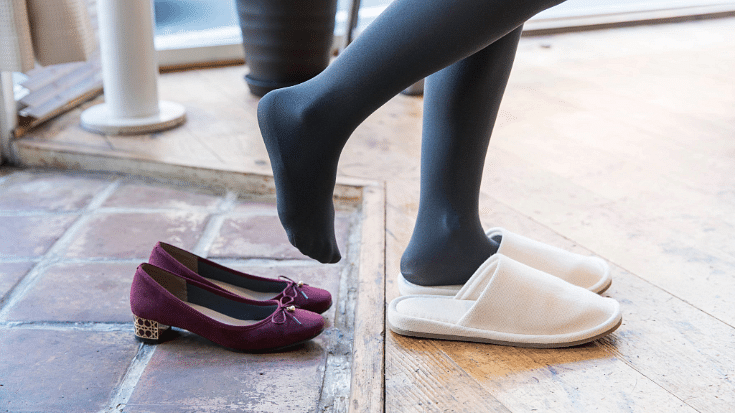
Adobe Free Stock / maru54
You’re always expected to remove your shoes at the door if you're invited into a Japanese house or apartment.
But walking around barefoot can feel a bit too casual or even slightly inconsiderate.
Wearing socks is the norm and a subtle sign of respect. Bonus points if they're clean and hole-free.
👣 Fun Fact: Genkan and Geta-Bako
The genkan is the entryway in Japanese homes where you leave your outdoor shoes behind. It's a little raised area that separates the outside world from the clean indoors.
Right next to it, you'll often find a geta-bako, or a shoe cupboard where families store their footwear, often complete with a shoehorn. It's neat, tidy, helpful and very Japan.
In Ryokan, Temples or Traditional Inns
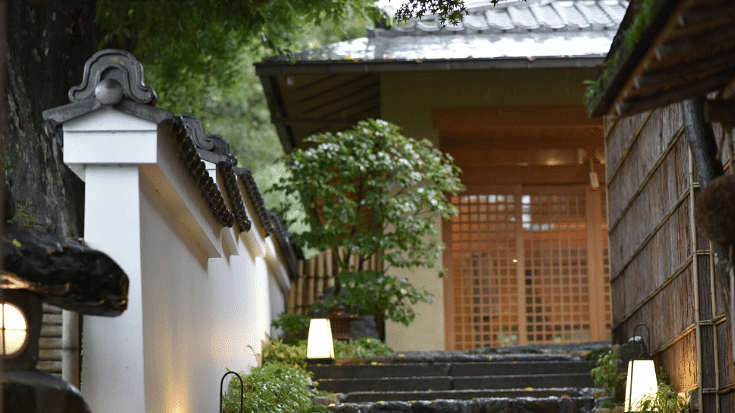
Adobe Free Stock / 光二 岡藤
Socks are strongly preferred in ryokans and temples.
You’ll often be given slippers to wear inside or specific bathroom slippers for toilet trips.
Walking around barefoot is usually fine in your own room, but not in communal areas.
Exception: Onsen and Tatami Rooms
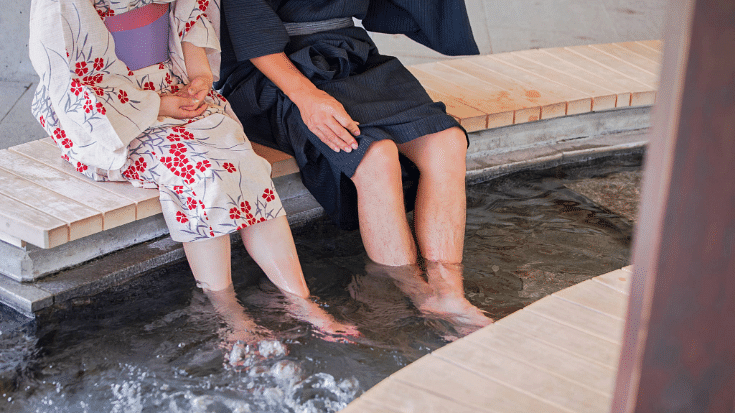
Adobe Free Stock / buritora
In places like an onsen, hot spring baths, barefoot is expected as you'll be clean and freshly washed.
On tatami mats, you'll be barefoot or in socks, but never in slippers or shoes.
Is It Rude To Be Barefoot Indoors In Japan?
Not rude, but not ideal either.
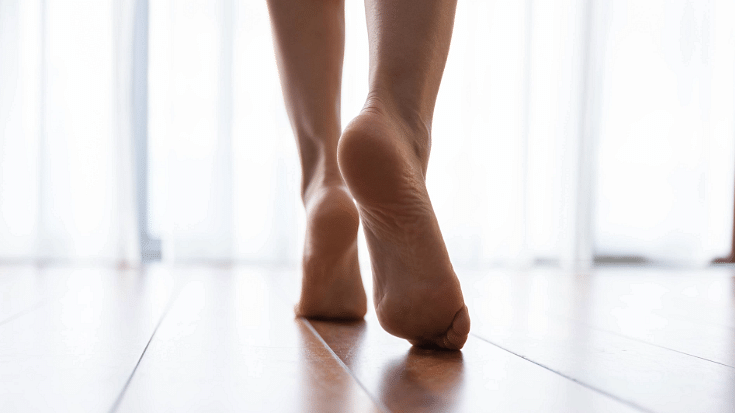
Adobe Free Stock / fizkes
Going barefoot indoors isn't considered offensive per se, but in many situations, it's seen as unhygienic or impolite.
Especially if you're a guest in someone's home or in a traditional setting.
A watertight tip is to carry a clean pair of socks with you at all times in Japan You really can't go wrong.

Adobe Free Stock / Sevendeman
10. Respect the Boundaries of Geisha
If you're visiting Kyoto, you're probably hoping to spot a geisha in person.
And fair enough, if so. It's one of the most iconic and enchanting experiences in Japan.
Years ago, before mass tourism, geiko - Kyoto's term for geisha - and their apprentices, called maiko, were rarely approached by outsiders.
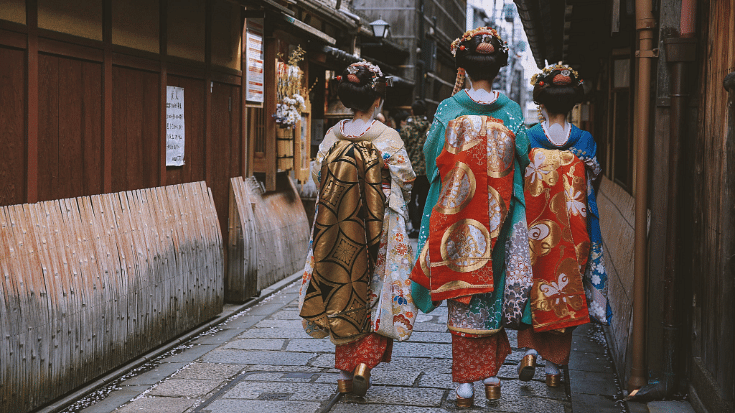
Adobe Free Stock / ZHAO YOULI
Fast forward to the present day and Kyoto city welcomes upwards of 50 million foreign and domestic tourists annually.
For the geiko and maiko still working in the historic Gion district, that can mean an overwhelming amount of unsolicited attention.
And sadly, in many cases, outright harassment.
Kyoto's official tourist board has released clear guidance around geiko and maiko etiquette due to a rise in intrusive behaviour from tourists.
Including stopping them for photos, following them down alleyways or touching their clothing.
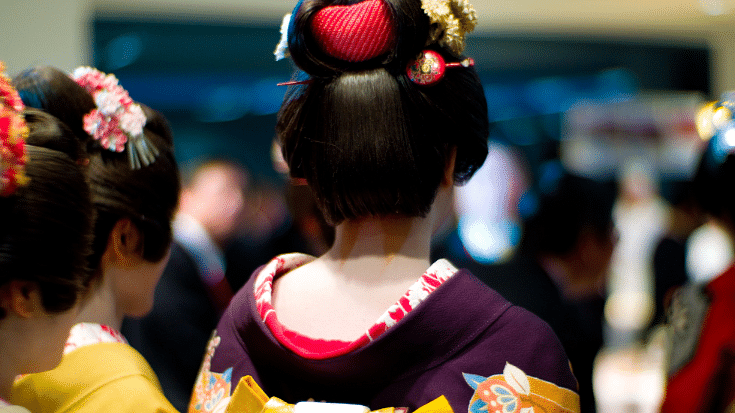
According to the Kyoto City Tourism Association, visitors should never:
- Stop, follow or touch a geiko or maiko
- Take unauthorised photos or videos of them
These are classed as nuisance behaviours and can result in real penalties:
- Stalking or obstructing their path: Up to 30 days of detention or a ¥10,000 fine
- Grabbing hands or clothing: Up to six months in prison or a fine of ¥500,000
As of April 2024, several private alleyways in Kyoto's Gion district have been closed off to tourists.
Signs mark these areas clearly and violating them can lead to fines of up to ¥10,000.
These measures aim to protect the privacy of geiko and maiko and the residents who live there.
It isn't about being unwelcoming. It's about preserving a living tradition and respecting the people who continue it.
And there are other ways to experience Kyoto’s geiko and maiko culture respectfully.
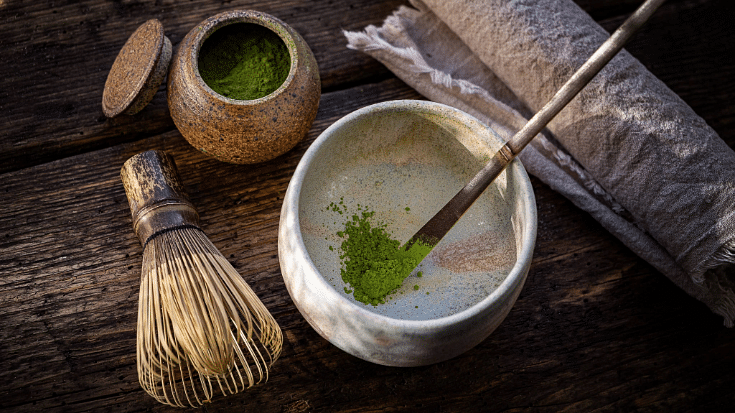
Image by Mirko Stödter from Pixabay
- Attend public performances like Kyomai at Gion Corner.
- Book a cultural experience, tea ceremony or guided tour that offers insight without intrusion.
- Visit during official festivals when their appearances are part of community celebrations.
By following these guidelines, you can appreciate Kyoto's cultural heritage while showing respect for its traditions and its people.
Finally - Things You Should Never Do In Japan
To wrap up, here are some no-nos that are not only frowned-upon, but are illegal in Japan.
Littering
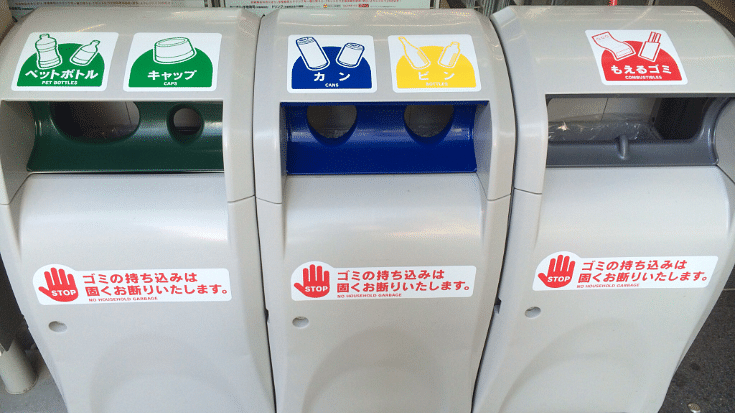
Wikimedia Commons / Steven-L-Johnson
Status: Illegal
Penalty: One of the first things you'll notice about Japan is its immense pride in its appearance. And this includes its cities and streets.
Hence, Japanese people are incredibly anti-litter and take littering extremely seriously.
Those caught littering can be fined hundreds or thousands of Yen. Many municipalities enforce additional regulations.
For instance, in Tokyo's Beautification Enforcement Areas, fines for littering can reach up to ¥50,000 (£260).
Something also worth noting is that public bins are scarce. So be prepared to carry your litter until you find one.
Not Disposing of Chewing Gum Properly

Image by Ryan McGuire from Pixabay
Status: Falls under littering laws
Penalty: While there isn't a specific national law targeting gum disposal, improper disposal can fall under general littering prohibitions, subjecting offenders to fines.
Dropping Cigarette Butts
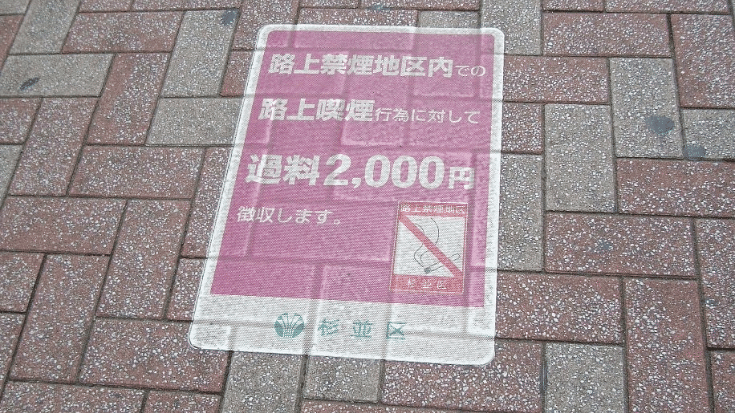
Wikimedia Commons / Harani0403
Status: Illegal
Penalty: Discarding cigarette butts improperly is treated as littering and is subject to fines. In areas like Tokyo's Chiyoda Ward, fines can be as high as ¥20,000, or £100. A top tip here is to buy a portable ashtray. Lots of locals use them, so you’ll fit right in.
Jaywalking
Status: Illegal
Penalty: Violations can result in fines up to ¥50,000 or imprisonment for up to three months.
The above probably reads like a litany of things you wouldn’t dream of doing anywhere as a responsible traveller.
But they're worth pointing out all the same.
One Last Tip - Make Life Easier with a Japan eSIM
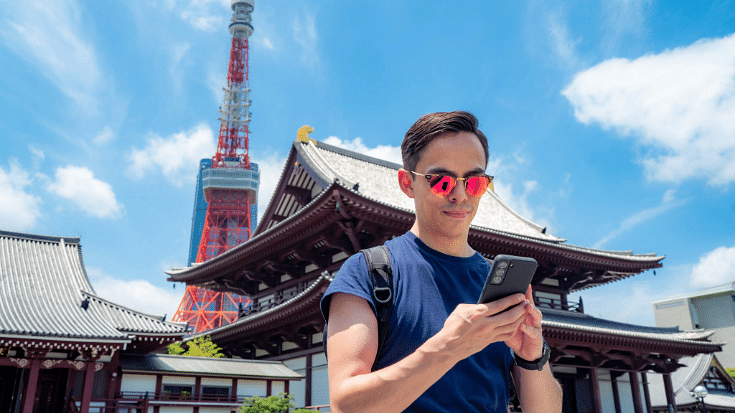
Adobe Free Stock / Itza
Diving right into new places and cultures is one of the exhilarating things we love about travel.
But in an unfamiliar place, uncertainty isn’t so great.
Make sure you can get online and access everything you need 24/7 with an eSIM from Airalo.
Whether you're trying to navigate the Tokyo Metro, translate a vending machine menu, or double-check geisha etiquette on the fly, having reliable data in your pocket makes all the difference.
Stay connected from the moment you land. No SIM card hunting, no waiting for free Wi-Fi to load, no roaming bill shocks.
Download your Japan eSIM from Airalo here and travel smart from day one.



